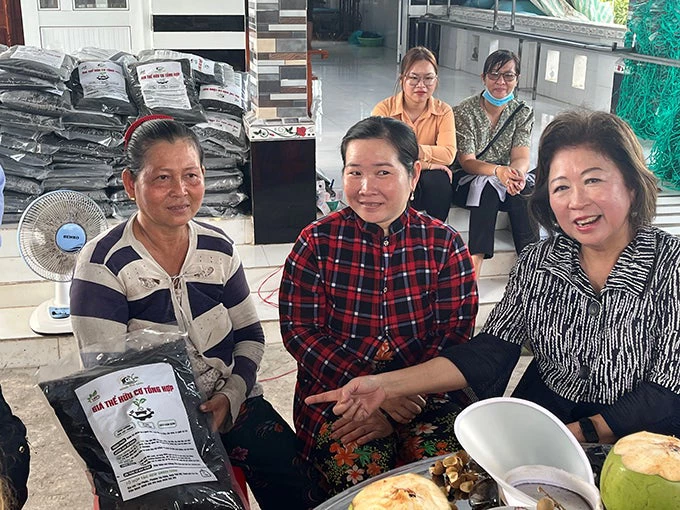 Cargo ships entering one of the busiest ports in the world, Singapore. Photo credit: Shutterstock.com
Cargo ships entering one of the busiest ports in the world, Singapore. Photo credit: Shutterstock.com
It’s easy to see how international trade contributes to climate change. The ships, trucks, and planes that move goods around the world contribute to greenhouse gas emissions. And the production of goods that are traded internationally – from foods like wheat and corn to goods like steel and cement – are also sources of emissions. All told, a quarter of greenhouse gas emissions have been linked to global trade flows.
Yet trade is also a vital part of the solution to climate change. If a storm or flood strikes, trade delivers emergency supplies of food and medicines and the goods needed to rebuild. And trade distributes the services, technologies, and goods that can reduce carbon emissions, such as solar panels and wind turbines.
Low and middle-income countries are at the center of the trade-climate nexus , according to a recent report from the World Bank. Collectively, their annual emissions grew faster than the world average over the 2010-2018 period. This has been largely attributed to the pursuit of their development goals in recent decades, although the combined total of their emissions remains less than those of the largest emitters, China and the United States, and they account for a tiny fraction of historical emissions. Yet, their economies are the most vulnerable to the effects of climate change. Many rely heavily on agriculture and tourism—sectors affected by rising temperatures and sea levels. What’s more, many have limited resources to adapt.

I had the opportunity recently to meet with communities in Vietnam and see how they are striving for “low carbon” rice production and export that uses less water and fertilizers, increases yields and incomes, and reduces CO2 emissions. Every country will have different priorities and needs to respond to climate change. Vietnam’s two most important sectors, agriculture and industry, are concentrated in coastal lowlands and deltas and are vulnerable to tropical storms and rising sea levels. Ethiopia, on the other hand, is prone to droughts, which pose a major risk to the cattle herds that are an important source of income for many of its 115 million people.
Rising global temperatures are reducing crop yields and farm labor productivity in low-income countries. According to one study, a 1-degree Centigrade increase in temperature lowers their agricultural exports by 39 percent, while for high-income countries the decline in exports is less than 6 percent. It is predicted that by 2030, an additional 70 million people will be at risk of hunger because of climate change, most of them in sub-Saharan Africa and South Asia.
These projections suggest that trade will play an increasingly important role in food security. Government trade policy measures can promote sustainable agriculture by fostering the spread of new technologies that can raise yields, such as new types of fertilizers and climate-resistant seed varieties. Improving access to digital technologies and data can help farmers reduce waste.
So, it will be important to lower tariffs on food as well as non-tariff barriers, such as arbitrary sanitary and phytosanitary standards and cumbersome border procedures. Tariffs on environmental goods and services should also come down. And when extreme weather events cause a crisis, as is becoming increasingly frequent, countries should refrain from export restrictions that exacerbate food shortages.
Countries are starting to take steps to reduce carbon emissions from transportation across borders. For example, under a plan worked out by the International Civil Aviation Organization, airlines in countries with the largest aviation industries will have to buy carbon offsets for emissions growth above 2019 levels.
The World Bank report suggests that global tariffs should be rebalanced in favor of less carbon-intensive goods. Currently, low tariff protection of carbon-intensive goods like bricks and fertilizers encourages more trading of these goods compared to cleaner industries like consumer goods. The difference in tariff treatment boosts demand for relatively cheaper, dirty industries. This creates an implicit “subsidy” to carbon estimated at between $500 and $800 billion per year through favorable tariff treatment.
The report also finds that climate change also opens new opportunities for low and middle-income countries. They are important producers of so-called environmentally preferable products—such as resins, colorants, and wool—that have less impact on the environment relative to competing goods that serve the same purpose. Countries with natural endowments conducive to wind or hydro power generation could become attractive locations for production of goods, such as green hydrogen, that require large amounts of electricity.
The World Bank report offers two additional suggestions for how countries could respond to the trade challenges posed by climate change , particularly following periods of extreme weather events that can affect food supply.
First, share more information on markets for essential goods like food and medicines. Greater transparency can lead to more informed and coordinated decisions that avoid damaging trade restrictions. Gathering and sharing information on global food stocks, for example, would be an important step.
Second, deepen cooperation at the regional and multilateral levels on trade issues that are critical for health and food security. Exporting countries could commit not to use restrictions in return for import tariff liberalization by importing countries. New Zealand and Singapore have shown the way: They agreed to reduce tariffs and refrain from export restrictions on 124 essential goods.
Trade has been an important driver of economic growth, lifting hundreds of millions of people out of poverty in recent decades. Adapting to a changing climate and shifting to a lower-carbon growth trajectory are key challenges for developing countries. Helping countries move toward green, resilient, and inclusive development requires understanding the new opportunities for developing countries to leverage trade for development. We are co-hosting a discussion on Driving Global Trade for Development with the Peterson Institute for International Economics on February 14, 2023. We hope you will participate in the conversation.


Join the Conversation